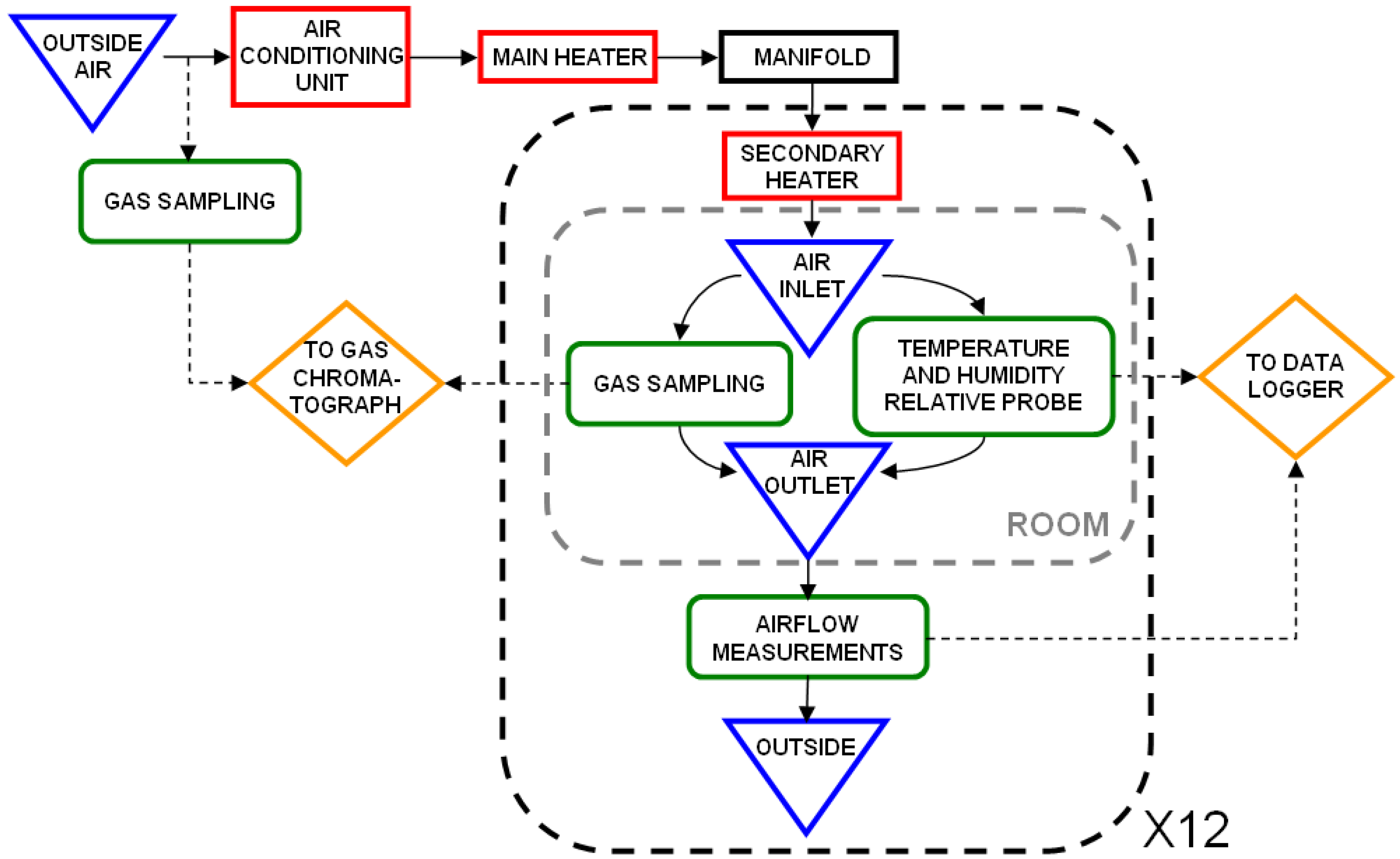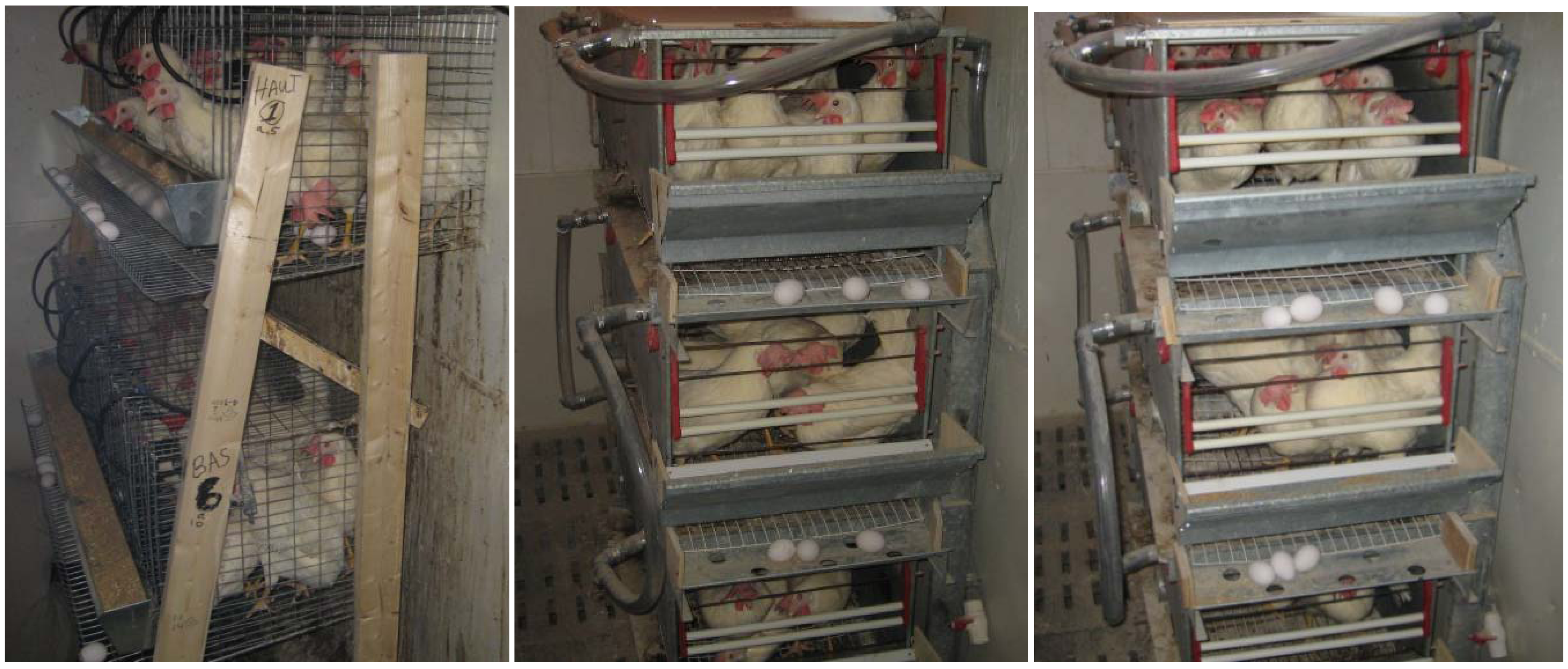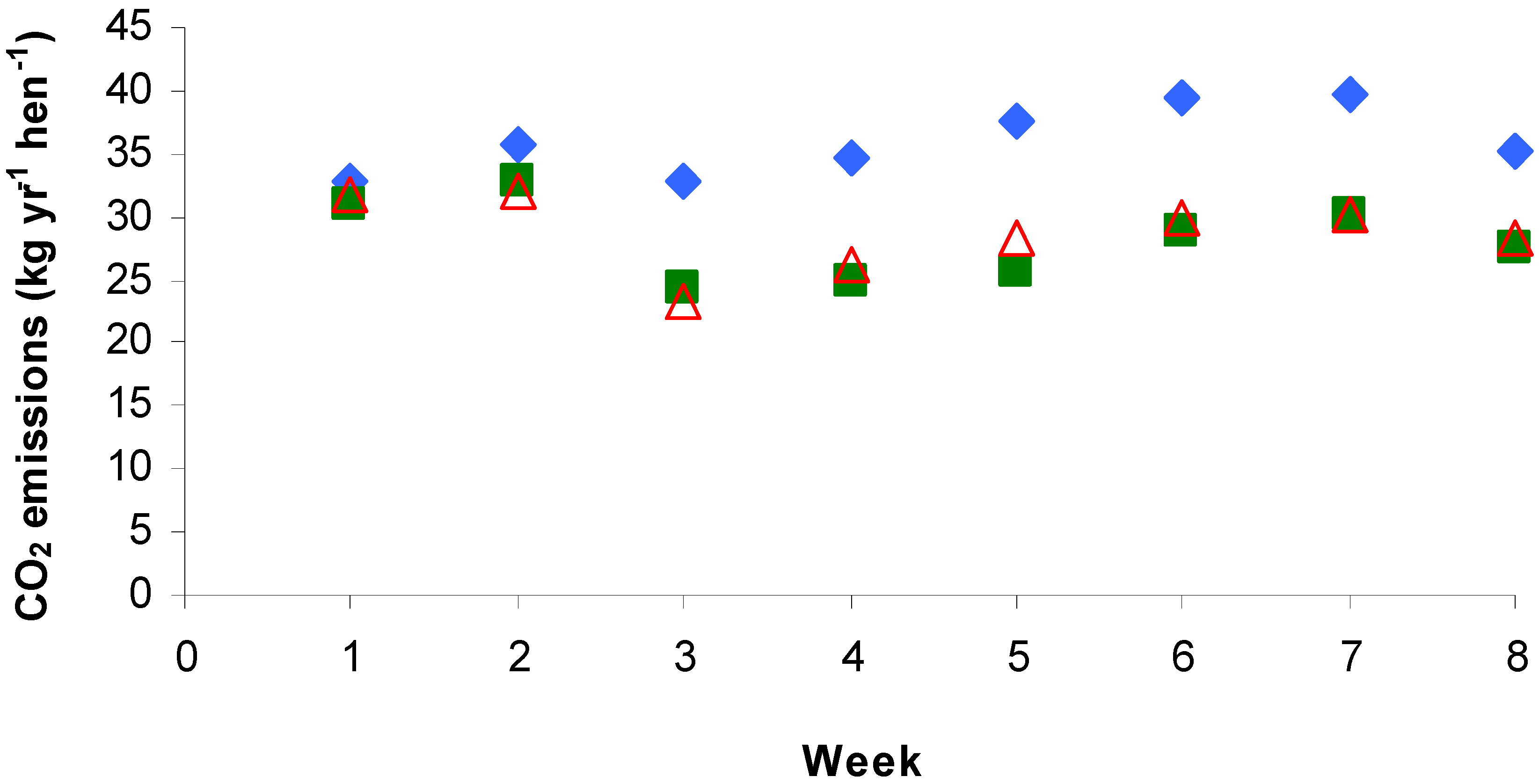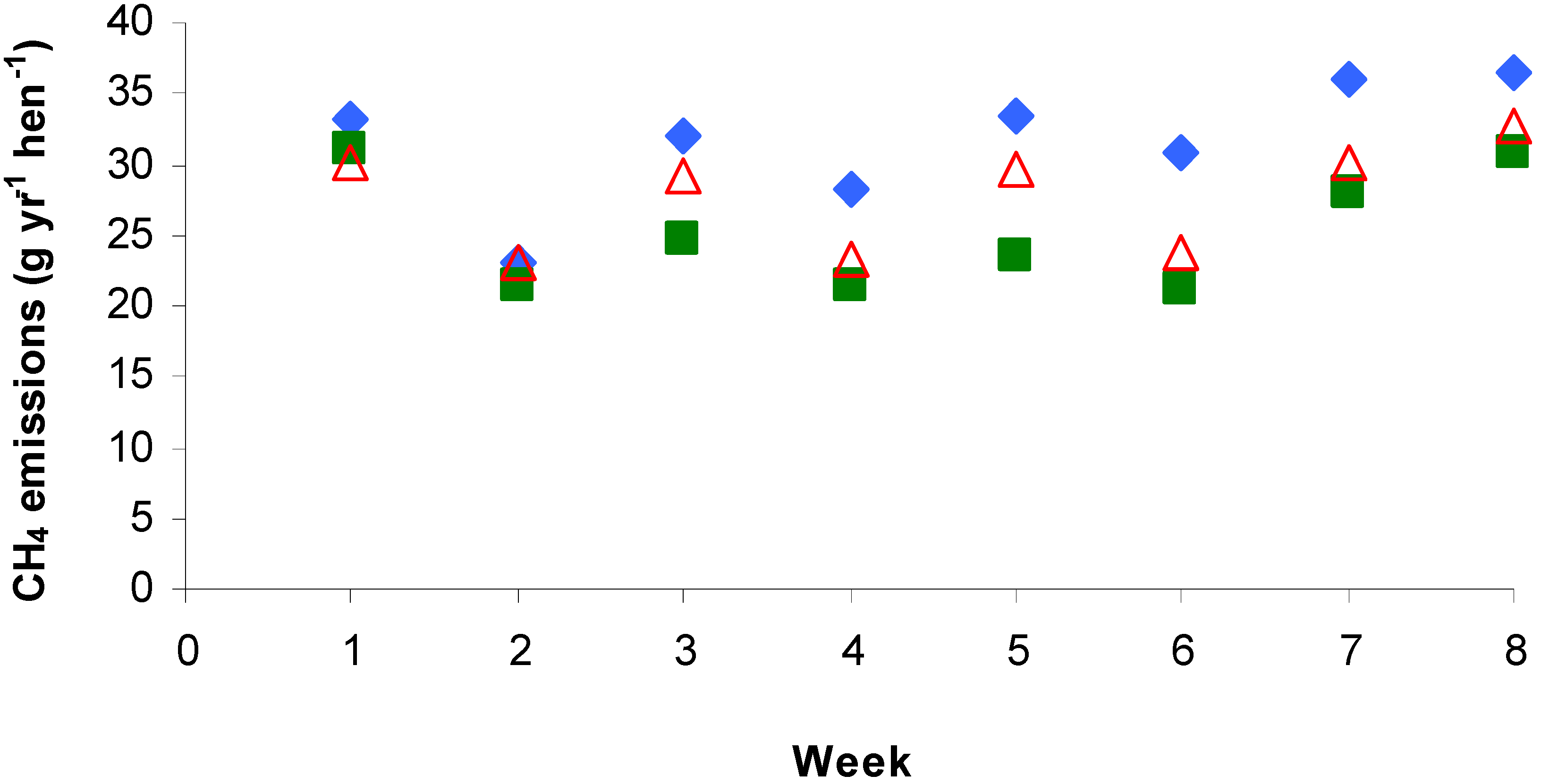Greenhouse Gas Emissions from Three Cage Layer Housing Systems
Abstract
:Simple Summary
Abstract
1. Introduction
| Greenhouse gas | Emissions a | |||
|---|---|---|---|---|
| Unknown system with battery cages | Manure belt with forced air drying | Deep-pit system | ||
| CO2 | n b | 2 | ||
| Mean | 26.5 | |||
| Range | 12.6–37.8 | |||
| Reference | [10,11] | |||
| CH4 | n b | 3 | 2 | 3 |
| Mean | 48.7 | 67.8 | 30.5 | |
| Range | 4.0–60.0 | 46.8–80.0 | 28.9–32.6 | |
| Reference | [11,12,13] | [14,15] | [14,16] | |
| N2O | n b | 3 | 1 | |
| Mean | 13.3 | 16.3 | ||
| Range | 13.1–30.0 | |||
| Reference | [10,17,18] | [16] | ||
2. Material and Methods
2.1. Experimental Rooms

2.2. Housing Systems
- (1)
- Deep liquid manure pit system—Hens were confined to a commercial cage system (Ranch Cunicole G.L.R. Inc., Saint-Hyacinthe, QC, Canada) measuring 1,524 mm long, 457 mm deep and 457 mm high. The two levels, assembled as an “A” frame, included five sections of 305 mm in length with three hens in each one (465 cm2 hen−1). Manure dropped beneath the cages into a pit at the bottom of the room where water was added to facilitate pumping the manure in a liquid form at the end of the trials;
- (2)
- Manure belt system with ND—Hens were reared in Farmer Automatic’s Multi-Deck battery cages (485.5 mm wide × 507 mm deep × 540 mm high) placed 2 × 2 on three decks for a total of six cages. Each cage included five hens (492 cm2 hen−1). Manure dropped on a belt beneath each row of cages and was removed twice a week;
- (3)
- Manure belt system with FAD—Manure dropped on a belt beneath each row of cages where it was dried with forced air and removed twice a week. The drying system was installed under all the decks of the Farmer Automatic’s battery cages. A perforated 7.5-cm duct blew air from a 10-cm blower (VTX-400, Atmosphere, Terrebonne, QC, Canada) located beneath the air inlet. Five-mm holes were placed at each 160 mm with a 45-degrees angle. Then, based on an air flow of 1.3 m3 h−1, the blower was adjusted to obtain an air velocity of 3.05 m s−1.

2.3. Animals, Lighting and Feeding
2.4. Temperature and Relative Humidity
2.5. Ventilation Rates
2.6. Composition of Manure
2.7. Greenhouse Gas Concentrations and Emissions
2.8. Experimental Design and Statistical Analysis
3. Results and Discussion
3.1. Environmental Parameters
3.2. Performance of the Laying Hens
3.3. Manure Characteristics
| Parameter | Deep liquid manure pit | Manure belt—natural drying | Manure belt—forced air drying | ||||
|---|---|---|---|---|---|---|---|
| Mean a | SD | Mean a | SD | Mean a | SD | ||
| Initial weight | kg hen−1 | 1.38 a | 0.04 | 1.37 a | 0.04 | 1.36 a | 0.06 |
| Final weight | kg hen−1 | 1.64 a | 0.06 | 1.65 a | 0.03 | 1.63 a | 0.03 |
| Food consumption | g d−1 hen−1 | 105.5 a | 3.4 | 93.1 b | 1.5 | 92.7 b | 2.0 |
| Water consumption | L d−1 hen−1 | 0.174 a | 0.018 | 0.160 b | 0.008 | 0.163 b | 0.014 |
| Egg production | egg d−1 hen−1 | 0.943 b | 0.015 | 0.950 a | 0.020 | 0.932 c | 0.027 |
| Conversion rate | kgfood dzeggs−1 | 1.34 a | 0.06 | 1.18 a | 0.03 | 1.19 a | 0.04 |
| Performance parameter | Liquid manure | Natural dried manure | Forced dried manure | |||||
|---|---|---|---|---|---|---|---|---|
| Mean a | SD | Mean a | SD | Mean a | SD | |||
| Manure quantities | g d−1 hen−1 | 140.2 a | 6.5 | 70.9 b | 7.5 | 60.8 b | 7.3 | |
| g DM d−1 hen−1 | 32.3 a | 1.5 | 26.2 a | 2.8 | 26.6 a | 3.2 | ||
| Dry matter content | DMC | % | 23.0 c | 2.0 | 37.0 b | 2.8 | 43.8 a | 4.4 |
| pH | 7.59 a | 0.12 | 6.66 b | 0.14 | 6.76 b | 0.08 | ||
| Total nitrogen | TN | g d−1 hen−1 | 0.97 b | 0.13 | 1.70 a | 0.12 | 1.64 a | 0.13 |
| Ammonium nitrogen | NH4-N | g d−1 hen−1 | 0.52 a | 0.10 | 0.26 ab | 0.05 | 0.19 b | 0.02 |
| Phosphorus | P | g d−1 hen−1 | 0.33 b | 0.03 | 0.46 a | 0.04 | 0.44 a | 0.04 |
| Potassium | K | g d−1 hen−1 | 0.45 b | 0.02 | 0.61 a | 0.04 | 0.59 ab | 0.05 |
| Calcium | Ca | g d−1 hen−1 | 1.39 a | 0.08 | 1.83 a | 0.06 | 1.81 a | 0.14 |
| Magnesium | Mg | g d−1 hen−1 | 0.105 a | 0.004 | 0.144 a | 0.006 | 0.138 a | 0.011 |
3.4. Carbon Dioxide Emissions
| Greenhouse gas | Emissions a | |||||
|---|---|---|---|---|---|---|
| Deep liquid manure pit | Manure belt— natural drying | Manure belt— forced air drying | ||||
| Mean | SD | Mean | SD | Mean | SD | |
| CO2 | 36.0 a | 8.3 | 28.2 b | 7.1 | 28.7 b | 6.3 |
| CH4 | 31.6 a | 22.9 | 25.3 b | 19.2 | 27.7 b | 20.2 |
| N2O | 2.78 a | 2.15 | 2.60 a | 2.04 | 2.48 a | 1.91 |
 ), manure belt with natural drying (
), manure belt with natural drying (  ) and manure belt with forced air drying (
) and manure belt with forced air drying (  ).
).
 ), manure belt with natural drying (
), manure belt with natural drying (  ) and manure belt with forced air drying (
) and manure belt with forced air drying (  ).
).
3.5. Methane Emissions
 ), manure belt with natural drying (
), manure belt with natural drying (  ) and manure belt with forced air drying (
) and manure belt with forced air drying (  ).
).
 ), manure belt with natural drying (
), manure belt with natural drying (  ) and manure belt with forced air drying (
) and manure belt with forced air drying (  ).
).
3.6. Nitrous Oxide Emissions
3.7. Greenhouse Gas Emissions
| Gas | Emissions (kg CO2-eq. yr−1 hen−1) | |||
|---|---|---|---|---|
| Name | Global warming potential | Deep liquid manure pit | Manure belt—natural drying | Manure belt—forced air drying |
| CH4 | 21 | 0.664 | 0.532 | 0.582 |
| N2O | 310 | 0.862 | 0.806 | 0.769 |
| Total | 1.53 | 1.34 | 1.35 | |
4. Conclusions
Acknowledgments
Conflict of Interest
References
- United Nations Development Programme (UNDP). Human Development Report 2007/2008—Fighting Climate Change: Human Solidarity in a Divided World; Palgrave Macmillan: New York, NY, USA, 2007; pp. 19–198. [Google Scholar]
- Agriculture and Agri-Food Canada (AAFC). Reducing Greenhouse Gas Emissions from Canadian Agriculture; Options Report; Publication No. 2028/E; The Agriculture and Agri-Food Canada Climate Change Table: Ottawa, ON, Canada, 2000; pp. 1–30. [Google Scholar]
- Pain, B. Gaseous Pollutants from Organic Waste Use in Agriculture. In Proceedings of the 8th International Conference of the FAO ESCORENA Network on Recycling of AgriculturalMunicipal and Industrial Residues in Agriculture, Rennes, France, 26–29 May 1998; pp. 233–246.
- Copeland, C. Air Quality Issues and Animal Agriculture: A Primer; CRS Report for Congress; RL-32948; Congressional Research Service: Washington, DC, USA, 2009; pp. 1–34. [Google Scholar]
- Bellarby, J.; Foereid, B.; Hastings, A.; Smith, P. Cool Farming: Climate Impacts of Agriculture and Mitigation Potential; Campaigning for Sustainable Agriculture, Greenpeace International: Amsterdam, The Netherlands, 2008; pp. 5–36. [Google Scholar]
- Steinfield, H.; Gerber, P.; Wassenaar, T.; Castel, V.; Rosales, M.; de Haan, C. Livestock's Long Shadow: Environmental Issues and Options; Food and Agriculture Organization of the United Nations (FAO): Rome, Italy, 2006; pp. 79–123. [Google Scholar]
- Gaulin, N. Fédération des producteurs d’oeufs de consommation du Québec (FPOCQ). Personal Communication.
- Fédération des producteurs d’oeufs de consommation du Québec (FPOCQ). Le portrait agroenvironnemental des fermes avicoles du Québec—Secteur oeufs de consommation. Available online: http://www.oeuf.ca/publications/nouveautes/ (accessed on 18 May 2010).
- Xin, H.; Gates, R.S.; Green, A.R.; Mitloehner, F.M.; Moore, P.A., Jr.; Wathes, C.M. Environmental Impacts and Sustainability of Egg Production Systems. Poultry Sci. 2011. [Google Scholar] [CrossRef]
- Neser, S.; Depta, G.; Stegbauer, B.; Gronauer, A.; Schön, H. Mass Balance of the Compounds Nitrogen and Carbon in Housing Systems for Laying Hens. In Proceedings of International Symposium on Ammonia and Odour Control from Animal Facilities, Rosmalen, The Netherlands, 6–10 October 1997; pp. 129–137.
- Wu-Haan, W.; Powers, W.J.; Angel, C.R.; Hale, C.E., III; Applegate, T.J. Effect of an Acidifying Diet Combined with Zeolite and Slight Protein Reduction on Air Emissions from Laying Hens of Different Ages. Poultry Sci. 2007, 86, 182–190. [Google Scholar]
- Groot Koerkamp, P.W.G.; Uenk, G.H. Climatic Conditions and Aerial Pollutants in and Emissions from Commercial Animal Production Systems in the Netherlands. In Proceedings of International Symposium on Ammonia and Odour Control from Animal Facilities, Rosmalen, The Netherlands, 6–10 October 1997; pp. 139–144.
- Monteny, G.J.; Groenestein, C.M.; Hilhorst, M.A. Interactions and Coupling Between Emissions of Methane and Nitrous Oxide from Animal Husbandry. Nutr. Cycl. Agroecosys. 2001, 60, 123–132. [Google Scholar] [CrossRef]
- Fabbri, C.; Costa, A.; Guarino, M.; Valli, L.; Mazzotta, V. Ammonia, Methane, Nitrous Oxide and Particulate Matter Emissions from Two Different Buildings for Laying Hens. Biosyst. Eng. 2007, 97, 441–455. [Google Scholar] [CrossRef]
- Hörnig, G.; Brunsch, R.; Stollberg, U.; Jelínek, A.; Plíva, P.; Češpiva, M. Ammonia, Methane and Carbon Dioxide Emissions from Laying Hens Kept in Battery Cages and Aviary Systems. In Proceedings of the 2nd Agricultural Engineering Conference of Central and East European Countries, Prague, Czech Republic, 23–24 October 2001; pp. 37–43.
- Wathes, C.M.; Holden, M.R.; Sneath, R.W.; White, R.P.; Phillips, V.R. Concentrations and Emissions Rates of Aerial Ammonia, Nitrous Oxide, Methane, Carbon Dioxide, Dust, and Endotoxin in U.K. Broiler and Layer Houses. Brit. Poultry Sci. 1997, 38, 14–28. [Google Scholar] [CrossRef]
- Chadwick, D.R.; Sneath, R.W.; Phillips, V.R.; Pain, B.F. A UK Inventory of Nitrous Oxide Emissions from Farmed Livestock. Atmos. Environ. 1999, 33, 3345–3354. [Google Scholar] [CrossRef]
- Sneath, R.W.; Phillips, V.R.; Demmers, T.G.M.; Burgess, L.R.; Short, J.L.; Welch, S.K. Long Term Measurements of Greenhouse Gas Emissions from UK Livestock Buildings. In Proceedings of the Fifth International Symposium on Livestock Environment V, Bloomington, MN, USA, 29–31 May, 1997; pp. 146–153.
- Hamelin, L.; Pelletier, F.; Godbout, S. Impacts environnementaux, économiques et sociaux des différentes chaînes de gestion des déjections des poules pondeuses; Institut de recherche et de développement en agroenvironnement (IRDA): Québec City, QC, Canada, 2007; pp. 1–61. [Google Scholar]
- Laguë, C. Management Practices to Reduce Greenhouse Gas Emissions from Swine Production Systems. Adv. Pork Product. 2003, 14, 287–300. [Google Scholar]
- Marquis, A. Émissions de gaz à effet de serre par les animaux aux bâtiments. In Proceedings of the 65e Congrès de l’Ordre des agronomes du Québec, 7–8 June 2002; Québec City, QC, Canada.
- Chadwick, D.R.; Pain, B.F.; Sneath, R.W.; Phillips, V.R. Methane and Nitrous Oxide Emissions from UK Agricultural Livestock. In Proceedings of the 8th International Conference of the FAO ESCORENA Network on Recycling of AgriculturalMunicipal and Industrial Residues in Agriculture, Rennes, France, 26–29 May 1998; pp. 279–291.
- Casey, K.D.; Bicudo, J.R.; Schmidt, D.R.; Singh, A.; Gay, S.W.; Gates, R.S.; Jacobson, L.D.; Hoff, S.J. Air Quality and Emissions from Livestock and Poultry Production/Waste Management Systems. In Animal Agriculture and the Environment; White Papers; Rice, J.M., Caldwell, D.F., Humenik, F.J., Eds., Eds.; 2006; pp. 1–40. National Center for Manure and Animal Waste Management: St. Joseph, MI, USA. [Google Scholar]
- Intergovernmental Panel on Climate Change (IPCC). IPCC Guidelines for National Greenhouse Gas Inventories; Egglestion, H.S., Buendia, L., Mowa, K., Ngara, T., Tanabe, K., Eds.; IGES: Hayama, Japan, 2006; Volume 4, pp. 10.1–10.94. [Google Scholar]
- Fournel, S. Étude comparative des emissions de gaz et d’odeurs issues de différents systèmes de gestion des déjections en production d’oeufs de consommation. M.S. Thesis, Université Laval, Québec, QC, Canada, 2011; pp. 1–91. [Google Scholar]
- Littell, R.C.; Milliken, G.A.; Stroup, W.W.; Wolfinger, R.D.; Schabenberger, O. SAS for Mixed Models, 2nd ed.; SAS Publishing: Cary, NC, USA, 2006. [Google Scholar]
- Seydoux, S.; Côté, D.; Grenier, M.; Gasser, M.-O. Caractérisation des volumes et des concentrations en éléments fertilisants des effluents d’élevages de poulettes et de poules pondeuses; Scientific Report to the “Centre de Référence en Agriculture et Agroalimentaire du Québec” (CRAAQ); “Institut de recherche et de développement en agroenvironnement” (IRDA):: Québec, QC, Canada, 2006; pp. 4–13. [Google Scholar]
- Lockyer, D.R.; Pain, B.F.; Klarenbeck, J.V. Ammonia Emissions from Cattle, Pig and Poultry Wastes Applied to Pasture. Environ. Pollut. 1989, 56, 19–30. [Google Scholar] [CrossRef] [PubMed]
- Groot Koerkamp, P.W.G. Review on Emissions of Ammonia from Housing Systems for Laying Hens in Relation to Sources, Processes, Building Design and Manure Handling. J. Agr. Eng. 1994, 59, 73–87. [Google Scholar] [CrossRef]
- da Borso, F.; Chiumenti, R. Poultry Housing and Manure Management Systems: Recent Fevelopments in Italy as Regards Ammonia Emissions. In Proceedings of the 8th International Conference of the FAO ESCORENA Network on Recycling of AgriculturalMunicipal and Industrial Residues in Agriculture, Rennes, France, 26–29 May 1998; pp. 15–21.
- Morris, B.A.; Taylor, T.G. The Daily Food Consumption of Laying Hens in Relation to Egg Formation. Brit. Poultry Sci. 1967, 8, 251–257. [Google Scholar] [CrossRef]
- Wood-Gush, D.G.M.; Horne, A.R. The Effect of Egg Formation and Laying on the Food and Water Intake of Brown Leghorn Hens. Brit. Poultry Sci. 1970, 11, 459–466. [Google Scholar] [CrossRef]
- Mongin, P.; Sauveur, B. Voluntary Food and Calcium Intake by the Laying Hens. Brit. Poultry Sci. 1974, 15, 349–359. [Google Scholar] [CrossRef]
- Scanes, C.G.; Campbell, R.; Griminger, P. Control of Energy Balance During Egg Production in the Laying Hen. J. Nutr. 1987, 117, 605–611. [Google Scholar] [PubMed]
- Zajaczkowski, F.J.; Casey, K.D.; Topper, P.; Zajaczkowski, J.S.; Li, H.; Gates, R.S.; Wheeler, E.F.; Liang, Y. Ammonia Emission for US Poultry Houses: Laying Hens. In Proceedings of the 2004 ASAE/CSAE Annual International Meeting, 1–4 August 2004; Ottawa, ON, Canada.
- Hilhorst, M.A.; Willers, H.C.; Groenestein, C.M.; Monteny, G.J. Effective Strategies to Reduce Methane Emissions from Livestock. In Proceedings of the ASAE Annual International Meeting, 30 July–1 August 2001; Sacramento, CA, USA.
- Jungbluth, T.; Hartung, E.; Brose, G. Greenhouse Gas Emissions from Animal Houses and Manure Stores. Nutr. Cycl. Agroecosys. 2001, 60, 133–145. [Google Scholar] [CrossRef]
© 2012 by the authors; licensee MDPI, Basel, Switzerland. This article is an open access article distributed under the terms and conditions of the Creative Commons Attribution license (http://creativecommons.org/licenses/by/3.0/).
Share and Cite
Fournel, S.; Pelletier, F.; Godbout, S.; Lagacé, R.; Feddes, J. Greenhouse Gas Emissions from Three Cage Layer Housing Systems. Animals 2012, 2, 1-15. https://doi.org/10.3390/ani2010001
Fournel S, Pelletier F, Godbout S, Lagacé R, Feddes J. Greenhouse Gas Emissions from Three Cage Layer Housing Systems. Animals. 2012; 2(1):1-15. https://doi.org/10.3390/ani2010001
Chicago/Turabian StyleFournel, Sébastien, Frédéric Pelletier, Stéphane Godbout, Robert Lagacé, and John Feddes. 2012. "Greenhouse Gas Emissions from Three Cage Layer Housing Systems" Animals 2, no. 1: 1-15. https://doi.org/10.3390/ani2010001
APA StyleFournel, S., Pelletier, F., Godbout, S., Lagacé, R., & Feddes, J. (2012). Greenhouse Gas Emissions from Three Cage Layer Housing Systems. Animals, 2(1), 1-15. https://doi.org/10.3390/ani2010001





